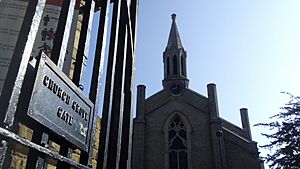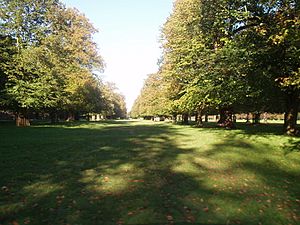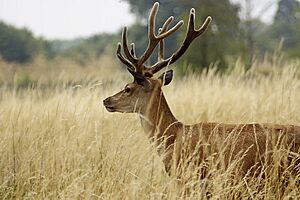Bushy Park facts for kids
| Site of Special Scientific Interest | |

Midwinter sunshine in Bushy Park
|
|
| Area of Search | Greater London |
|---|---|
| Interest | Biological |
| Area | 357.0 |
| Notification | 2014 |
| Location map | Magic Map |
Bushy Park is a huge park in London. It's the second largest of London's Royal Parks, covering about 445 hectares (that's like 1,100 football fields!). You can find it just north of Hampton Court Palace. It's a great place to visit and explore.
In 2014, most of Bushy Park became a special protected area. It was named a biological Site of Special Scientific Interest (SSSI). This means it's important for its plants and animals. The park is also listed as a Grade I historic park, showing its special history and design.
Contents
History of Bushy Park
People have lived in the area now called Bushy Park for a very long time. The oldest things found here are from the Bronze Age, about 4,000 years ago! In the Middle Ages, people used the land for farming.
Royal Hunting Grounds
In 1529, Henry VIII took over Hampton Court Palace. He also claimed the land that is now Bushy Park. Henry VIII loved to hunt, so he made these areas his deer-hunting grounds.
Later kings and queens added beautiful features to the park. Charles I of England ordered the building of the Longford River. This 19-kilometer canal brought water to Hampton Court Palace. The park's many ponds were also added around this time.
Chestnut Avenue and Diana Fountain
The main road through the park is called Chestnut Avenue. It runs from Teddington to the Lion Gate entrance of Hampton Court Palace. This avenue and the famous Arethusa 'Diana' Fountain were designed by Sir Christopher Wren. He wanted them to be a grand entrance to the palace.
For many years, people have loved visiting Bushy Park. Before World War II, Londoners would come here to celebrate "Chestnut Sunday." They would see the beautiful chestnut trees blooming along Chestnut Avenue. This tradition was brought back in 1993.
Bushy Park During Wartime
During World War I, Bushy Park was home to the King's Canadian Hospital. It helped soldiers who were hurt. Between the wars, it even hosted a camp for children who needed better food.
During World War II, something very important happened here. General Dwight D. Eisenhower planned the D-Day landings from his headquarters in the park. D-Day was a huge event that helped end the war.
A special memorial now marks the spot where General Eisenhower's tent stood. It honors the Allied troops who fought on D-Day. Nearby, Eisenhower House is named after him, and Shaef Gate is named after his headquarters.
Bushy Park Today
Bushy Park was first created for royal sports. Today, it's still a hub for sports! It's home to several rugby, hockey, and cricket clubs. In fact, the rules for modern field hockey were largely created here in 1871.
The park also has places for fishing and model boating. You can go horse riding, enjoy beautiful gardens, and explore wildlife areas. Bushy Park is famous for its herds of red deer and fallow deer. You can often spot them roaming freely!
The park also has several buildings, including Bushy House and the National Physical Laboratory (NPL). There are also two areas where people can grow their own vegetables in allotments.
Parkrun
The very first Parkrun started in Bushy Park in 2004. It's a free 5K (about 3.1 miles) run that happens every Saturday morning. Up to 1,500 runners join each week! There are also special runs on Christmas Day and New Year's Day.
Water Gardens
In 2009, the beautiful Upper Lodge Water Gardens were restored and reopened. They are a wonderful place to visit and enjoy the peaceful surroundings.
Getting to Bushy Park

It's easy to get to Bushy Park by train or bus. The closest train stations are Hampton Court, Hampton Wick, Teddington, Fulwell, and Hampton. They are all about a 10 to 20-minute walk away.
Many Transport for London bus routes also stop near the park's entrances. You can find buses like the 111, 216, 411, R70, R68, 285, and 481 that will get you close.
If you're driving, the main north and south gates are connected by Chestnut Avenue. You can drive through the park from 6:30 AM until dusk. You can also cycle through the park on special paths.
Plants and Animals
Bushy Park is a very important place for nature. It has many different types of habitats, like grasslands, woods, and areas with old trees. These habitats are home to a huge variety of insects and other small creatures. There are also over two hundred very old, special trees in the park.
Scientists even found a new type of fungus gnat here! It's a kind of fly that was new to the UK. It was named Grzegorzekia bushyae, also known as the Bushy Gnat, after the park. This shows how unique the wildlife in Bushy Park is!
Images for kids
See also
 In Spanish: Bushy Park para niños
In Spanish: Bushy Park para niños




